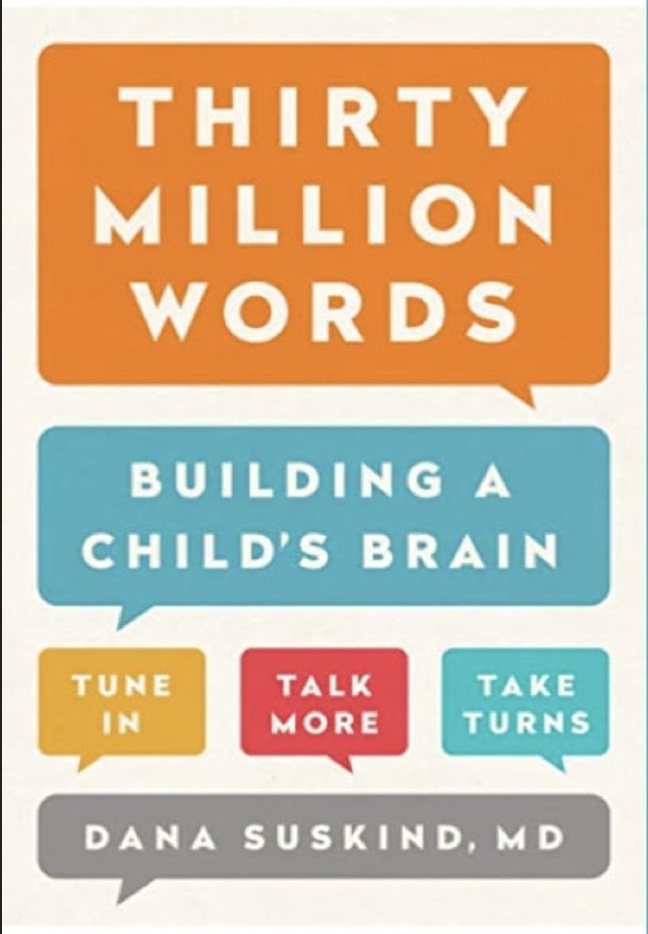”In parent-child conversations, there is “business talk” and “extra talk.” Business talk is necessary in all families as it helps keep daily life running. The extra talk, or chit-chat, has an extraordinarily rich impact on child development” (p. 43).
Key Points and Concepts
Language Quantity
A cochlear implant is an electronic medical device that restores hearing by replacing the function of the inner ear. For a cochlear implantation to be successful, children need to receive the implant before age three or four to connect sound to meaning. After this point, the brain is still plastic, but will never be able to reach average speech comprehension levels (p. 6).
Researchers from the University of Kansas, Hart and Risely, conducted a monumental experiment in the 1960s that challenged the idea, ‘you’re smart because you were born smart, and dumb because you were born dumb.’ They found that children born into poverty heard far fewer words, and heard words delivered far less constructively, than their affluent peers (p. 22).
Hart and Risley observed families from different socio-economic classes for six months in a series of one-hour sessions. In the most affluent families, children heard an average of a 1,000 words per hour and parents responded to their children about 250 times per hour, while children in low-income families heard 600 words per hour and were responded to fewer than 50 times by their parents. Over a year, children from high-income families will hear approximately 11,000,000 words while children from welfare families will hear 3,000,000 words—a 8,000,000 word difference (p. 34).
By the time children are three years old, children from professional families know 1,116 words while children from welfare families know an average of 525 words (p. 35).
Once researchers controlled for income, they realized that not all low-income children suffered from delayed language and not all affluent children excelled. It’s not a matter of economic wealth, but the richness of the language environments, which is often, but not always, linked to socioeconomic status (p. 38).
Language Quality
Mere exposure to language isn’t enough. Children who hear words from the television or computer screen do not retain what they heard nearly as well as when they have a conversation. Learning occurs in the context of a social interaction (p. 189).
Children who hear more words are also more likely to hear more affirmative feedback. Supportive conversations are made from the following components:
1. Symbol-infused joint attention: parent and child use language and gestures to share an activity.
2. Communication fluency and connectedness: equal contributions from parent and child.
3. Routines and rituals: establishing daily events like morning breakfast or bedtime stories.
More affluent families reprimand their children far less than low-income families. So while children in low-income families hear fewer words, a higher percentage of them send the message “you’re wrong.”
Children from affluent families hear about 166,000 affirmations (“great job!”) and 26,000 prohibitions (“stop that!”) per year, while welfare children hear an average of 26,000 affirmations and 57,000 prohibitions. When the dominant message children hear is negative, they’re likely to internalize damaging self-beliefs (p. 45).
In parent-child conversations, there is “business talk” and “extra talk.” Business talk is necessary in all families as it helps keep daily life running. The extra talk, or chit-chat, has an extraordinarily rich impact on child development (p. 43).
A great way to get more “chit-chat” into conversations with children is to narrate what you’re doing and why. The process of narrating your actions helps young children connect the relationship between sound, words, action, and things. The more colorful and descriptive the narration, the more the child learns and the richer their vocabulary grows (p. 144).
Parentese, or “baby-talk,” from parents helps babies process language, since it captures babies attention. Children who listen to the most parentese, instead of adult-talk, learn words faster (p. 137).
Gendered Patterns in Parent-Child Communication
In studies focusing on gendered parent-child communication, researchers discovered that daughters under the age of two receive less than half of the math and spatially related talk as sons. Essentially from birth onwards, knowingly or not, parents steer their daughters away from STEM fields, like science, technology, engineering, and math. In girls as young as seven, several studies revealed that highperforming girls self-assess themselves as inferior in math to their male counterparts, even when their test scores indicate otherwise (p. 96).
“One of the greatest ironies is that the gender stereotypes seem to be a legacy handed down from mother to daughter, a reflection of one generation’s insecurity being passed on to the next generation, ad infinitum. Moms consistently overestimate their sons’ math abilities while underestimating their daughters’, even when confronted with actual math achievement. There is also more of a tendency to get sons involved in math activities, influencing both actual participation and interest” (p. 96).
In families that claimed they want to raise their sons and daughters the same, researchers still find gendered differences in the way parents praise their children. From as young as fourteen months old, girls are more likely to be praised for their “innate” abilities and boys are more likely to receive process-based praise (p. 107).
The way parents talk about math to their children sends the message to their daughters that if they succeed it’s because they worked hard, but if they fail it’s because they weren’t talented enough. Boys are sent a very different message—if they succeed it’s because they are talented, and if they fail it’s because they didn’t work hard (p. 97).
In another telling study, researchers Beilock and Levine studied the math anxiety of elementary school teachers and how that impacted student performance. Nationwide, 90 percent of teachers are female. By the end of the year, girls who had the most math-anxious teachers were more likely to draw a picture of a boy when they were asked to draw a student good at math and a girl when asked to draw a student good at reading (p. 97).
Mindset
Mindset is key to overcoming gendered stereotypes of women in math and science professions. By eighth grade, boys significantly outperform girls in math, but only if girls believe intelligence is fixed and gender specific. For girls who believe that intelligence is malleable, the effects of gender stereotyping practically disappear (p. 100).
Professor Carol Dweck discovered that praising students for being “smart” is damaging, because, when students fail, they believe they just weren’t smart enough. For students who believe that they achieved success through hard work and are praised for their effort, they’re more likely to stick to difficult tasks (p. 104).
One of the biggest problems educators face is the mindset of parents. If parents believe they can’t do anything to make their children smarter, why try anything differently? Mothers with a fixed-mindset are more likely to criticize when their children try a new task, or take over the task and complete it for them, crippling their child’s growth and sense of autonomy (p. 201).
Parents who have the mindset of a disciplinarian are often on the lookout for when their children are misbehaving. Instead, look for opportunities to catch children being good more often. Children learn what not to do by reprimands, but they learn what they should do when praised for good behavior (p. 172).
Raising Creative, Independent Thinkers
A great way to help improve children’s math and spatial abilities is to describe the world in relative terms using comparative speech, e.g. “Which train is the fastest?” “Look at how far you threw that ball! How much father did you throw it than the last time?” “Can you fill this cup with less water than the other cup?” (p. 168).
Children who talk to themselves are better at self-regulating their emotions. Parents can encourage personal dialogue by asking children to take responsibility for their behavior through suggestions and prompts instead of directives. It’s the difference between mandating children to “put your toys away now” and asking children, “what should we do with the toys now that we’re finished with them?”
The first mandates obedience, the second asks children to engage in process-based critical thinking (pp. 115-118).
To raise a kind child, it’s helpful to praise the person. When a child is helpful, saying “I liked the way you helped me” might encourage your child to help you again, but it does not encourage children to internalize the idea that they’re a helpful person. A better way is to thank children for being a helpful person. Likewise, children are more likely to pitch in during chores if you ask them to be “helpers” instead of asking them to “help” you (p. 135).
Use fewer “what” questions e.g. “What does a dog say?” “What color is this?” etc. because it only asks that children retrieve what they already know. Instead, ask children open-ended “how” and “why” questions that allow them to practice new sequences of language and thought (p. 150).
Creativity is not an innate talent, but a tendency towards exploration. When viewed in this way, children who squeak toys are practicing creative thought. When they build with blocks and cups or engage in pretend play, they’re engaging in creative thought. The more creative they think, the more independent they become (p. 185).
“Because” thinking makes for more cooperative children. Asking a child to “go put on socks” is often met with ornery behavior. Asking your child to “Go get your socks because we need to keep your feet warm” helps children understand why something is important and fosters the belief that commands should have a solid rationale if they’re to be followed. Likewise, “Saying ‘eat your breakfast’ may get
a child to eat, but telling the child why sets up a lifetime understanding of the need for food for health” (p. 179).
Many parents know the importance of reading, but get frustrated when their children interrupt, try to hold the book themselves, or turn the page before they’re ready. A better approach is to tune into what’s grabbing the child’s attention and talking about it, pausing the reading. Ask children what they think will happen, talk to them about your own reactions, and ask open-ended questions. This requires reflection, conjecturing, and higher-level thought (p. 155).
Suskind, D. (2015) Thirty Million Words: Building a Child’s Brain. New York: Penguin Random House LLC.

“In families that claimed they want to raise their sons and daughters the same, researchers still find gendered differences in the way parents praise their children. From as young as fourteen months old, girls are more likely to be praised for their “innate” abilities and boys are more likely to receive process-based praise.”
“Creativity is not an innate talent, but a tendency towards exploration. When viewed in this way, children who squeak toys are practicing creative thought. When they build with blocks and cups or engage in pretend play, they’re engaging in creative thought. The more creative they think, the more independent they become.”
“Many parents know the importance of reading, but get frustrated when their children interrupt, try to hold the book themselves, or turn the page before they’re ready. A better approach is to tune into what’s grabbing the child’s attention and talking about it, pausing the reading.”
